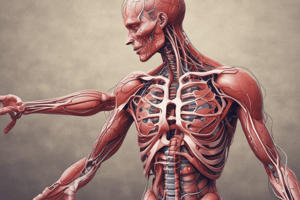Podcast
Questions and Answers
What is the primary function of the cardiovascular system?
What is the primary function of the cardiovascular system?
To deliver oxygen and nutrients to cells and remove waste products
What are the four chambers of the heart?
What are the four chambers of the heart?
Left and right atria, and left and right ventricles
What is the difference between elastic arteries and muscular arteries?
What is the difference between elastic arteries and muscular arteries?
Elastic arteries, such as the aorta, are stretchy and accommodate the high pressure of blood pumped from the heart, while muscular arteries, such as arterioles, are thicker and more muscular to regulate blood flow
What is the function of the one-way valves in veins?
What is the function of the one-way valves in veins?
What is the role of capillaries in blood circulation?
What is the role of capillaries in blood circulation?
What are the components of blood?
What are the components of blood?
What is the difference between pulmonary and systemic circulation?
What is the difference between pulmonary and systemic circulation?
What is the unit of measurement for blood pressure?
What is the unit of measurement for blood pressure?
How does the autonomic nervous system regulate heart rate and blood pressure?
How does the autonomic nervous system regulate heart rate and blood pressure?
What is the role of baroreceptors in blood pressure regulation?
What is the role of baroreceptors in blood pressure regulation?
Flashcards are hidden until you start studying
Study Notes
Overview
- The cardiovascular system, also known as the circulatory system, is a network of organs and vessels that transport blood throughout the body.
- Its primary function is to deliver oxygen and nutrients to cells and remove waste products.
Components
Heart
- A muscular organ that pumps blood throughout the body
- Divided into four chambers: left and right atria, and left and right ventricles
- The heart beats around 100,000 times per day
Arteries
- Blood vessels that carry oxygenated blood away from the heart to the rest of the body
- Divided into two categories: elastic arteries (e.g., aorta) and muscular arteries (e.g., arterioles)
- Arteries branch into smaller arterioles, which further branch into capillaries
Veins
- Blood vessels that carry deoxygenated blood back to the heart
- Have one-way valves to prevent backflow
- Merge to form larger veins, which return blood to the heart
Blood Vessels
- Capillaries: tiny vessels where oxygen and nutrients are exchanged with cells
- Venules: small vessels that collect blood from capillaries and merge to form veins
Blood
- A liquid tissue that transports oxygen, nutrients, hormones, and waste products
- Composed of:
- Plasma (liquid portion)
- Red blood cells (carry oxygen)
- White blood cells (part of immune system)
- Platelets (involved in blood clotting)
Blood Circulation
- Pulmonary circulation: deoxygenated blood flows from heart to lungs, picks up oxygen, and returns to heart
- Systemic circulation: oxygenated blood flows from heart to rest of body, delivers oxygen and nutrients, and returns to heart
- Blood pressure: the force exerted by blood on blood vessel walls, measured in mmHg
Regulation
- Autonomic nervous system regulates heart rate and blood pressure
- Baroreceptors in blood vessels detect changes in blood pressure and signal the brain to make adjustments
- Hormones, such as epinephrine, can also affect heart rate and blood pressure
Overview
- The cardiovascular system is a network of organs and vessels that transport blood throughout the body.
- Its primary function is to deliver oxygen and nutrients to cells and remove waste products.
Components
Heart
- A muscular organ that pumps blood throughout the body.
- Divided into four chambers: left and right atria, and left and right ventricles.
- Beats around 100,000 times per day.
Arteries
- Carry oxygenated blood away from the heart to the rest of the body.
- Divided into elastic arteries (e.g., aorta) and muscular arteries (e.g., arterioles).
- Branch into smaller arterioles, which further branch into capillaries.
Veins
- Carry deoxygenated blood back to the heart.
- Have one-way valves to prevent backflow.
- Merge to form larger veins, which return blood to the heart.
Blood Vessels
- Capillaries: tiny vessels where oxygen and nutrients are exchanged with cells.
- Venules: small vessels that collect blood from capillaries and merge to form veins.
Blood
- A liquid tissue that transports oxygen, nutrients, hormones, and waste products.
- Composed of plasma (liquid portion), red blood cells (carry oxygen), white blood cells (part of immune system), and platelets (involved in blood clotting).
Blood Circulation
- Pulmonary circulation: deoxygenated blood flows from heart to lungs, picks up oxygen, and returns to heart.
- Systemic circulation: oxygenated blood flows from heart to rest of body, delivers oxygen and nutrients, and returns to heart.
- Blood pressure: the force exerted by blood on blood vessel walls, measured in mmHg.
Regulation
- Autonomic nervous system regulates heart rate and blood pressure.
- Baroreceptors in blood vessels detect changes in blood pressure and signal the brain to make adjustments.
- Hormones, such as epinephrine, can also affect heart rate and blood pressure.
Studying That Suits You
Use AI to generate personalized quizzes and flashcards to suit your learning preferences.



